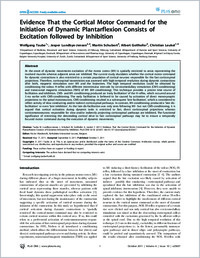Evidence that the cortical motor command for the initiation of dynamic plantarflexion consists of excitation followed by inhibition
- Taube, Wolfgang Department of Medicine, Movement and Sport Science, University of Fribourg, Switzerland
- Lundbye-Jensen, Jesper Department of Exercise and Sport Sciences, University of Copenhagen, Denmark - Department of Neuroscience and Pharmacology, University of Copenhagen, Denmark
- Schubert, Martin Spinal Cord Injury Centre, Balgrist University Hospital, University of Zurich, Switzerland
- Gollhofer, Albert Department of Sport Science, University of Freiburg, Germany
- Leukel, Christian Department of Medicine, Movement and Sport Science, University of Fribourg, Switzerland - Department of Sport Science, University of Freiburg, Germany
-
07.10.2011
Published in:
- PLoS ONE. - 2011, vol. 6, no. 10, p. e25657
English
At the onset of dynamic movements excitation of the motor cortex (M1) is spatially restricted to areas representing the involved muscles whereas adjacent areas are inhibited. The current study elucidates whether the cortical motor command for dynamic contractions is also restricted to a certain population of cortical neurons responsible for the fast corticospinal projections. Therefore, corticospinal transmission was assessed with high temporal resolution during dynamic contractions after both, magnetic stimulation over M1 and the brainstem. The high temporal resolution could be obtained by conditioning the soleus H-reflex with different interstimulus intervals by cervicomedullary stimulation (CMS-conditioning) and transcranial magnetic stimulation (TMS) of M1 (M1-conditioning). This technique provides a precise time course of facilitation and inhibition. CMS- and M1-conditioning produced an ‘early facilitation’ of the H-reflex, which occurred around 3 ms earlier with CMS-conditioning. The early facilitation is believed to be caused by activation of direct monosynaptic projections to the spinal motoneurons. CMS-conditioning resulted in a subsequent ‘late facilitation’, which is considered to reflect activity of slow-conducting and/or indirect corticospinal pathways. In contrast, M1-conditioning produced a ‘late dis-facilitation’ or even ‘late inhibition’. As the late dis-facilitation was only seen following M1- but not CMS-conditioning, it is argued that cortical activation during dynamic tasks is restricted to fast, direct corticospinal projections whereas corticomotoneurons responsible for slow and/or indirectly projecting corticospinal pathways are inhibited. The functional significance of restricting the descending cortical drive to fast corticospinal pathways may be to ensure a temporally focused motor command during the execution of dynamic movements.
- Faculty
- Faculté des sciences et de médecine
- Department
- Département de Médecine
- Language
-
- English
- Classification
- Biological sciences
- License
-
License undefined
- Identifiers
-
- RERO DOC 28198
- DOI 10.1371/journal.pone.0025657
- Persistent URL
- https://folia.unifr.ch/unifr/documents/302237
Statistics
Document views: 106
File downloads:
- pdf: 144
